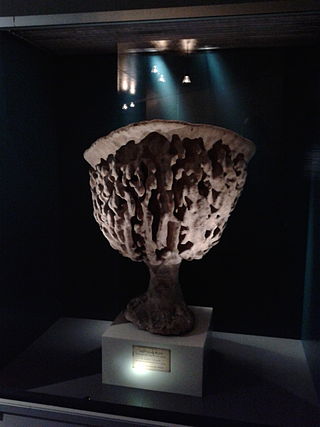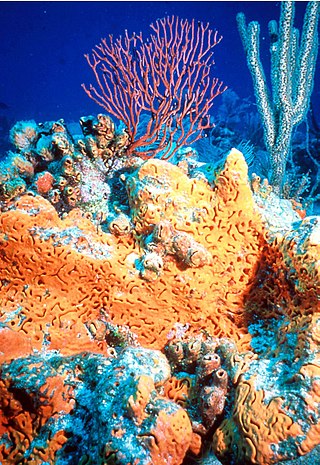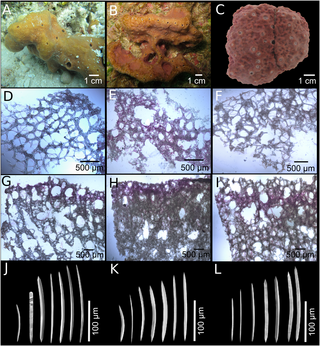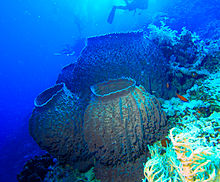
Sponges, the members of the phylum Porifera, are a basal animal clade as a sister of the diploblasts. They are multicellular organisms that have bodies full of pores and channels allowing water to circulate through them, consisting of jelly-like mesohyl sandwiched between two thin layers of cells.

Demosponges (Demospongiae) are the most diverse class in the phylum Porifera. They include greater than 90% of all species of sponges with nearly 8,800 species worldwide. They are sponges with a soft body that covers a hard, often massive skeleton made of calcium carbonate, either aragonite or calcite. They are predominantly leuconoid in structure. Their "skeletons" are made of spicules consisting of fibers of the protein spongin, the mineral silica, or both. Where spicules of silica are present, they have a different shape from those in the otherwise similar glass sponges. Some species, in particular from the Antarctic, obtain the silica for spicule building from the ingestion of siliceous diatoms.

Spongilla is a genus of freshwater sponges containing over 200 different species. Spongilla was first publicly recognized in 1696 by Leonard Plukenet and can be found in lakes, ponds and slow streams.Spongilla have a leuconoid body form with a skeleton composed of siliceous spicules. They are sessile organisms, attaching themselves to hard substrate like rocks, logs and sometimes to ground. Using their ostia and osculum these sponges filter the water for various small aquatic organisms such as protozoans, bacteria, and other free-floating pond life. Sponges of the genus Spongilla partake in symbiotic relationships with green algae, zoochlorellae. The symbiotic zoochlorellae give the sponges a green appearance and without them they would appear white.

The giant barrel sponge is the largest species of sponge found growing on Caribbean coral reefs. It is common at depths greater than 10 metres (33 ft) down to 120 metres (390 ft) and can reach a diameter of 1.8 metres. It is typically brownish-red to brownish-gray in color, with a hard or stony texture.

Ircinia strobilina is a species of sponge in the family Irciniidae. It is grey or shiny black in colour, with spiny structures (conules) dotting the surface. The spiny structures are interconnected by ridges, though not arranged in an orderly lattice. This species is globular and massive in shape, but usually no more than 0.3 metres (1 ft) across. I. strobilina is lobed and spherical and has a tough consistency. The large excurrent pores are located in depressions at the top of the sponge. Many smaller incurrent pores are scattered across the surface, more densely at the sides.
Pseudospongosorites is a genus of sea sponges belonging to the family Suberitidae. Currently, the genus is considered as monotypic, consisting of a single species Pseudospongosorites suberitoides. It is found in the Caribbean Sea, the Gulf of Mexico and on the Atlantic coast of the United States as far north as North Carolina. This species is known by the common name Florida hermit crab sponge, so named because hermit crabs often use it as shelter.

Spongia officinalis, better known as a variety of bath sponge, is a commercially used sea sponge. Individuals grow in large lobes with small openings and are formed by a mesh of primary and secondary fibers. It is light grey to black in color. It is found throughout the Mediterranean Sea up to 100 meters deep on rocky or sandy surfaces.

Cliona patera, commonly called Neptune's cup sponge, is a species of demosponge in the family Clionaidae.
Homaxinella is a genus of sea sponges in the family Suberitidae. The type species is Homaxinella balfourensis.
Homaxinella balfourensis is a species of sea sponge in the family Suberitidae. It is found in the seas around Antarctica and can grow in two forms, either branching out in one plane like a fan or forming an upright club-like structure.

Agelas is a genus of sea sponge in the class Demospongiae.

Xestospongia is a genus of sponges in the family Petrosiidae. It contains the following species:

Petrosiidae is a family of sponges, first described in 1980 by Rob van Soest which contains the following four genera:

Neopetrosia proxima is a species of marine petrosiid sponge native to the tropical and subtropical waters of the western Atlantic Ocean.
Neopetrosia subtriangularis is a species of marine petrosiid sponges native to the waters off Florida and the Caribbean Sea. They superficially resemble staghorn corals.

Agelas tubulata is a species of demosponge. It is tube-shaped or vase-shaped and variable in colour. It is found in the Caribbean area and along the coasts of Brazil at depths of between about 70 and 90 m. It was first described by Lehnert & Rob van Soest in 1996, the type location being the Greater Antilles.
Halisarca caerulea is a species of sponge in the family Halisarcidae. It is native to the Caribbean Sea and was first described in 1987 by the French marine biologists Jean Vacelet and Claude Donadey.
Calcifibrospongiidae is a family of sponges belonging to the order Haplosclerida. The order Haplosclerida is distinguished by isodictyal skeleton. In general, Porifera are basal animals with bodies full of pores and channels. Calcifibrospongiidae includes the species Calcifibrospongia actinostromarioides. There have only been ten recorded occurrences of this species: in Hogsty Reef and San Salvador, as well as in the subtropics of the Bahamas.

Robertus Wilhelmus Maria (Rob) van Soest, born in 1946, is a Dutch marine biologist. He works at the Naturalis Biodiversity Center and is also affiliated with the University of Amsterdam. He co-authored with John N. A. Hooper Systema Porifera: A Guide to the Classification of Sponges, a standard reference for sponge classification.












